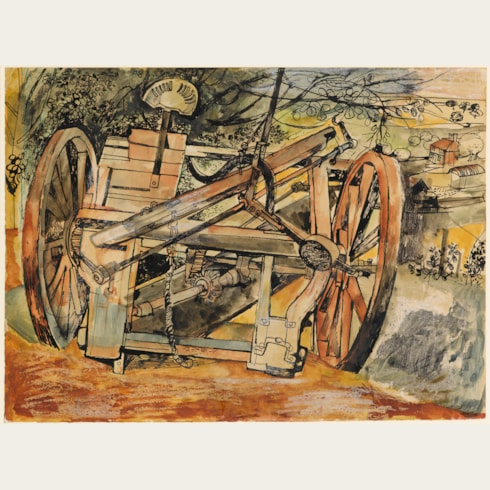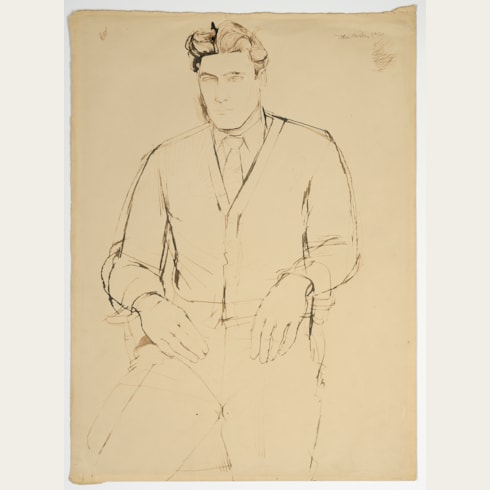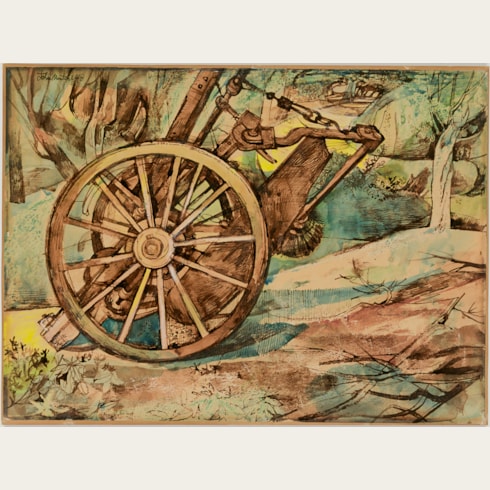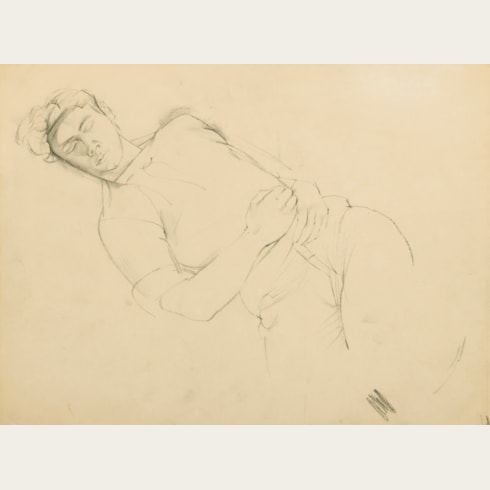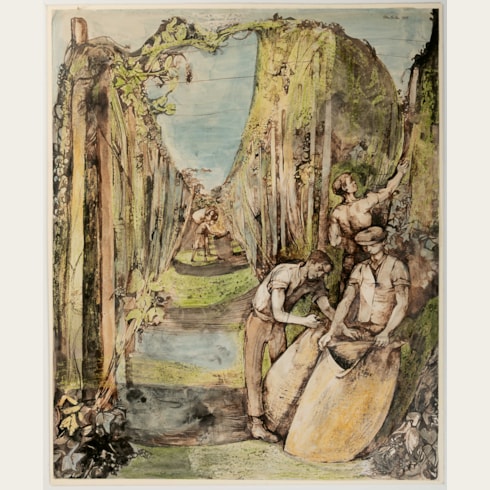John MINTON
(Great Shelford 1917 - London 1957)
Portrait of a Seated Youth (Eric Verrico)
Sold
Pencil on white paper.
388 x 237 mm. (15 1/4 x 9 3/8 in.) [image]
460 x 292 mm. (18 1/8 x 11 1/2 in.) [sheet]
388 x 237 mm. (15 1/4 x 9 3/8 in.) [image]
460 x 292 mm. (18 1/8 x 11 1/2 in.) [sheet]
The present sheet is a portrait of Eric Verrico, a pupil at the Camberwell School of Arts and Crafts, and one of a group of young students who gathered around the inspiring figure of Minton and became known as ‘Johnny’s Circus’. Possessed of ‘astonishing good looks’ and ‘looking as if had stepped out of a Caravaggio’, Verrico frequently posed for Minton, appearing in such paintings as Cornish Boy at a Window of 1948, today in the Government Art Collection. Conscripted into the R.A.F. Verrico changed his surname to Verrier and lost touch with Minton.
A painted portrait of Verrico of 1948, for which this drawing may have served as a preliminary study, is in the collection of the Royal Albert Memorial Museum in Exeter. Another portrait of the same sitter, painted a year earlier, was formerly in the collection of Muriel Belcher, while Verrico had earlier appeared with two fellow Camberwell students in a triple portrait painted by Minton in 1946, now in the Tel Aviv Museum of Art.
In his painted and drawn portraits of friends and students, Minton often preferred to depict his subjects seated and seen from a high vantage point, and with the sitter’s hands clasped in his lap. These pencil portraits, ‘superb examples at their best of unforced draughtsmanship’, in the words of one critic and friend8, are among Minton’s finest drawings.
A painted portrait of Verrico of 1948, for which this drawing may have served as a preliminary study, is in the collection of the Royal Albert Memorial Museum in Exeter. Another portrait of the same sitter, painted a year earlier, was formerly in the collection of Muriel Belcher, while Verrico had earlier appeared with two fellow Camberwell students in a triple portrait painted by Minton in 1946, now in the Tel Aviv Museum of Art.
In his painted and drawn portraits of friends and students, Minton often preferred to depict his subjects seated and seen from a high vantage point, and with the sitter’s hands clasped in his lap. These pencil portraits, ‘superb examples at their best of unforced draughtsmanship’, in the words of one critic and friend8, are among Minton’s finest drawings.
Although he had only a relatively brief career before his death at the age of thirty-nine, John Minton was enormously prolific and achieved a great deal of success in his lifetime. Between 1945 and 1956 he had eight one-man shows, mainly at the Lefevre Gallery in London, as well as taking part in a number of group shows and the Royal Academy Summer exhibitions. Alongside his output as a painter and draughtsman, he provided numerous illustrations for books, book jackets, magazines and advertisements, and also designed posters, wallpaper and stage sets.
While he enjoyed considerable early success, by the 1950’s Minton’s work was becoming overshadowed by that of other artists in his circle, notably Lucian Freud and Francis Bacon. As a friend of his later wrote, ‘He saw himself as overtaken by fashions in art – abstract expressionism among others – for which he had no liking. While others of his contemporaries – Lucien Freud, Francis Bacon, Keith Vaughan - held their ground and came through, Minton saw himself as obsolete, as eccentric and old-fashioned as Edward Lear. He could not come to terms with new developments and he lost faith in his own talent…He was, I suppose, one of those kingfisher-like specimens whose bright plumage briefly glinted then was gone. It might, perhaps, have been different in other circumstances; a little more patience and he could have survived the disorienting shifts in taste.’
Minton devoted much of his later career to teaching, in particular at the Royal College of Art, and was a popular and inspirational figure among his students. As Frances Spalding has written of him, ‘Minton’s virtuoso performances with pencil or pen and ink commended him as a teacher. His students aspired to his dexterity and adopted his devices.’ Minton died, by his own hand, in January 1957.
Provenance
Michael Parkin Gallery, London, in 1991
Anonymous sale, London, Christie’s, 11 March 1994, lot 105
Modern British Artists, London
Anonymous sale, London, Christie’s South Kensington, 15 July 1998, lot 142.





